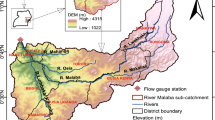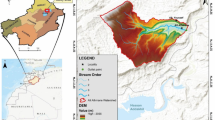Abstract
Flood mitigation measures are essential in several aspects of environmental sustainability, such as environmental protection and development, infrastructure resilience, and climate change adaptation strategies. This study investigates several remedial measures such as flood and disaster risk reduction strategies to protect Baledwayne City, Somalia. The developed hydrological-hydraulic model is successfully calibrated using the 2019 flood event. Inundation maps for different mitigation measures are developed to determine the most appropriate one(s) that may reduce flood impact and protect the city, especially the residential areas, against peak discharge of a 500-year return period. The investigated mitigation measures include (1) operating the Warabole Diversion Canal, (2) building two detention ponds at the upstream sections of both right and left floodplains, (3) building levees (dikes) along both sides of Shabelle River, and (4) restoration of the river. Results show that the remedial measures for the Warabole Diversion Channel and the river restoration are insufficient to protect the city. Building ponds on the right- and left-hand sides of the river substantially protects the city from flooding by reducing the flooded area from 88.6 to 31.5 km2, which is equivalent to a reduction of 35.5%. Construction of dikes on both sides of the river does not protect the city by overflowing an area of 75.2 km2 (84.9%). A combination of several measures is also investigated and it is found that ponds must be built along with any alternative measure. When all four measures are combined, it becomes clear that the city’s residential areas would be fully protected, significantly reducing the overall flooded area of the city to 27.9 km2 (31.5%). These flooded areas are behind the detention pond, which is designed to hold floodwater and gradually drain it back to the river.






















Similar content being viewed by others
Data availability
The data are available by the corresponding author upon request.
References
Attaran S, Mosaedi A, Qeidari HS, Derakhshandeh JF (2024) Co-evolution of human and hydrological system: presenting a socio-hydrological approach to flood adaptation in Kalat city, Iran. Int J Disaster Risk Reduct 102:104292
Basnyat D (2009) Hydraulic analysis of rivers Juba and Shabelle in Somalia basic analysis for irrigation and flood management purposes. https://doi.org/10.13140/RG.2.2.12795.36643
Buishand TA (1982) Some methods for testing the homogeneity of rainfall records. J Hydrol 58(1):11–27. https://doi.org/10.1016/0022-1694(82)90066-X
Calver A, Stewart E, Goodsell G (2009) Comparative analysis of statistical and catchment modelling approaches to river flood frequency estimation. J Flood Risk Manag 2(1):24–31
Chow VT, Maidment DR, Mays LW (1988) Applied hydrology. McGraw- Hill Book Company, New York
Cunge JA (1969) On the subject of a flood propagation computation method (Musklngum method). J Hydraul Res 7(2):205–230
FAO (2020) Gu 2020 Rainfall performance (March to June 2020) (Issue July). https://reliefweb.int/report/somalia/gu-2020-rainfall-performance-march-june-2020-issued-22-july-2020
FAO-SWALIM (2016) Disaster management plan for the Juba and Shabelle basins in Somalia (Issue January). https://www.faoswalim.org/content/w-27-disaster-managemnet-plan-juba-and-shabelle-basins-somalia
FAO-SWALIM (2019a) Flood monitoring tool, statistics per season. https://floods.faoswalim.org/dashboard/?category2=2019;ampcategory=Deyr
FAOSWALIM (2019b) Soil_100K_S_FAOSWALIM. https://spatial.faoswalim.org/layers/geonode:Soil_100K_S_FAOSWALIM#/
FAOSWALIM (n.d.) Manual Rainfall Stations: MRS_HIBEL - Beledwayne. https://climseries.faoswalim.org/rainfall/data/mrs/MRS_HIBEL
Gadain HM, Jama AM (2009) Flood risk and response management. Technical Report No W-15 produced under “Support to the Sustainable Management of the Shebelle and Juba Rivers in Southern Somalia Project” (Issue December). http://www.faoswalim.org/subsites/frrmis/index.php
Haltas I, Yildirim E, Oztas F, Demir I (2021) A comprehensive flood event specification and inventory: 1930–2020 Turkey case study. Int J Disaster Risk Reduct 56:102086. https://doi.org/10.1016/j.ijdrr.2021.102086
ISRIC—World Soil Information (2020) World soil distribution. https://www.isric.org/explore/world-soil-distribution
Karra K, Kontgis C, Statman-Weil Z, Mazzariello JC, Mathis M, Brumby SP (2021) Global land use/land cover with Sentinel 2 and deep learning. IEEE Int Geosci Remote Sens Symp IGARSS 2021:4704–4707. https://doi.org/10.1109/IGARSS47720.2021.9553499
Lu Y, Ekeanyanwu CN, Blanchard D (2024) Untangling the myth of flood risk and mitigation in affluent inland urban neighbourhood—a case study of the Onion Creek Neighbourhood in Austin, Texas. Int J Disaster Risk Reduct 101:104237
Mishra SK, Singh V (2003) Soil conservation service curve number (SCS-CN) methodology, vol 42. Springer, Dordrecht
MOP (2020) Somalia national development plan 2020 to 2024. http://mop.gov.so/wp-content/uploads/2019/12/NDP-9-2020-2024.pdf
Moriasi DN, Arnold JG, Van Liew MW, Bingner RL, Harmel RD, Veith TL (2007) Model evaluation guidelines for systematic quantification of accuracy in watershed simulations. Trans ASABE 50(3):885–900
Munich RE (2000) Topics 2000: natural catastrophes-the current position. Munich Reinsurance Company, Munich RE
OCHA (2018) Flood response plan Somalia (Issues 15 May-15 August). https://www.humanitarianresponse.info/sites/www.humanitarianresponse.info/files/documents/files/somalia_flood_response_plan_may_-_august_2018_0.pdf
OCHA (2019) OCHA Somalia Flash Update #4 Humanitarian impact of flooding| 6 November 2019 (Issue November). https://reliefweb.int/report/somalia/ocha-somalia-flash-update-4-humanitarian-impact-flooding-6-november-2019
OCHA (2020) Flood response plan Somalia (Issue June). https://reliefweb.int/report/somalia/somalia-flood-response-plan-june-2020
Olajuyigbe AE, Rotowa OO, Durojaye E (2012) An assessment of flood hazard in Nigeria: the case of mile 12. Lagos Mediterr J Soc Sci 3(2):367
Patrick S (2011) Weak links: fragile states, global threats, and international security. Oxford University Press
Raes D, Willems P, Gbaguidi F (2006) RAINBOW–a software package for hydrometeorological frequency analysis and testing the homogeneity of historical data sets. In: Proceedings of the 4th international workshop on sustainable management of marginal drylands. Islamabad, Pakistan, 2731(January), 12
Rumsby BT (1991) Flood frequency and magnitude estimates based on valley flood morphology and floodplain sedimentary sequences: the Tyne Basin. Newcastle University, NE England
Samantaray S, Sahoo A (2020) Estimation of flood frequency using statistical method: Mahanadi River basin, India. H2Open J 3(1):189–207
Sebhat MY, Wenninger J (2014) Water balance of the Juba and Shabelle River basins the Horn of Africa. Int J Agri Pol Res 2: 238–255
UN ESCAP (2015). Overview of natural disasters and their impacts in Asia and the Pacific 1970–2014. United Nations. https://hdl.handle.net/20.500.12870/3096
UNDP (2004) Reducing disaster risk: a challenge for development. United Nations Development Programme
World Population Review (2020) World Population Review. https://worldpopulationreview.com/
Wu H, Adler RF, Hong Y, Tian Y, Policelli F (2012) Evaluation of global flood detection using satellite-based rainfall and a hydrologic model. J Hydrometeorol 13(4):1268–1284. https://doi.org/10.1175/jhm-d-11-087.1
Zaifoglu H, Yanmaz AM, Akintug B (2019) Developing flood mitigation measures for the northern part of Nicosia. Nat Hazards 98(2):535–557. https://doi.org/10.1007/s11069-019-03713-1
Author information
Authors and Affiliations
Contributions
Conceptualization: Abdullahi A. Ibrahim, Gokmen Tayfur. Methodology: Abdullahi A. Ibrahim, Gokmen Tayfur. Implementation of the computer code and algorithms: Abdullahi A. Ibrahim. Validation: Gokmen Tayfur, Mir Jafar Sadegh Safari. Formal analysis: Abdullahi A. Ibrahim, Gokmen Tayfur. Investigation: Abdullahi A. Ibrahim, Gokmen Tayfur, Mir Jafar Sadegh Safari. Resources: Abdullahi A. Ibrahim. Data Curation: Abdullahi A. Ibrahim. Writing—Original Draft: Abdullahi A. Ibrahim, Gokmen Tayfur. Writing—Review and Editing: Gokmen Tayfur, Mir Jafar Sadegh Safari. Supervision: Gokmen Tayfur. Visualization: Gokmen Tayfur, Mir Jafar Sadegh Safari.
Corresponding author
Ethics declarations
Conflict of interest
The authors declare no competing interests.
Additional information
Publisher's Note
Springer Nature remains neutral with regard to jurisdictional claims in published maps and institutional affiliations.
Rights and permissions
Springer Nature or its licensor (e.g. a society or other partner) holds exclusive rights to this article under a publishing agreement with the author(s) or other rightsholder(s); author self-archiving of the accepted manuscript version of this article is solely governed by the terms of such publishing agreement and applicable law.
About this article
Cite this article
Ibrahim, A.A., Tayfur, G. & Safari, M.J.S. Developing feasible structural flood mitigation measures for arid regions using hydrological and hydraulic modelling: a case of Baledweyne City, Somalia. Sustain. Water Resour. Manag. 11, 55 (2025). https://doi.org/10.1007/s40899-025-01231-6
Received:
Accepted:
Published:
DOI: https://doi.org/10.1007/s40899-025-01231-6




